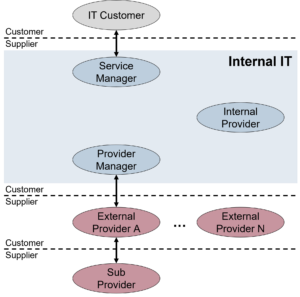IT Service Manager versus Provider Manager: in many companies the terms Service Manager and Provider Manager are used for roles in the IT area. Since there is no accepted standard definition for these terms, the understanding of the roles they refer to in companies varies greatly. Sometimes they are used synonymously for one and the same position in IT. Corresponding job titles also appear repeatedly in the corresponding job portals. Below, we will show on the one hand a demarcation, but also the necessary interaction between the two roles. The basic definitions are based on the most common usage in the market. Our main focus, however, is the design of customer and supplier management.
First of all, I will explain the two roles and distinguish them from each other before we come to the dependencies and the interaction of the two roles. Both roles have key functions in the service provider chain of an IT department (see Figure 1).
The role of the service manager
A service manager ensures that the IT services offered internally always meet the requirements of his or her IT customer. He or she has a sales-oriented role and is the first point of contact for the customer. This requires a basic understanding of the business, requirements and processes of his or her customers as well as soft skills for dealing with the customer. In particular, he or she will be responsible for the following tasks:
- Ensuring that the service agreements concluded with the customer are adhered to – this implies representing the customer’s interests in his own IT organization,
- SLA reporting and regular service review meetings with the customer,
- advising the customer on the existing IT service offering,
- coordination of the demand with the customer,
- Recording new customer requirements and initiating the resulting service changes and new services in his own IT organization.
From an ITIL point of view, this is a mixture of tasks from the management practices Relationship Management, Service Level Management and (still included in ITIL V3) Demand Management.
The role of the Provider Manager
The provider manager ensures that the IT services purchased from “his” external providers always meet the requirements of the internal service portfolio. His role has a clear focus on supplier management. He is the central contact person for the provider’s service manager. He must have a good overview of the current internal (i.e. defined in the service catalogue) service offering, service changes currently being planned and the entire service organization. He must also have soft skills; in this case for dealing with his providers as well as with internal colleagues from other functional areas. In particular, he will be responsible for the following tasks:
- Ensuring that the service agreements concluded with the provider are adhered to – this implies representing the interests of the own IT organization towards the provider,
- review of SLA reports and invoices from the provider, regular service review meetings with the provider,
- coordination and commissioning of necessary service changes and new services on the provider side, ensuring correct implementation and commissioning of the changes,
- ensuring appropriate risk and compliance management regarding externally sourced services,
- management of the identification and implementation of improvement potentials and innovations in the service segment of the provider,
- monitoring of provider-related budgets.
From the point of view of ITIL, this includes the management practices Supplier Management and Measurement & Reporting, but in some cases goes far beyond them.

Figure 1: Role arrangement in the service provider chain
Demarcation and interaction of the two roles
As you can see, the tasks of the two roles are not so different: Both are concerned with the provision of services in accordance with agreements and – in an increasingly agile world – with the acceptance and implementation of necessary service changes. But the focus is different in each case:
The service manager as part of “IT sales” ensures that the internal service offering always meets the (constantly changing) needs of the customer. His goal is “sales success”, i.e. to achieve planned turnover, customer satisfaction and long-term customer loyalty. Today, the latter is no longer a matter of course for the internal IT department: With quickly accessible, easy-to-order cloud services, there is a danger that internal IT customers will increasingly – bypassing the IT department and purchasing – purchase services externally (keyword: maverick buying).
The provider manager, on the other hand, must ensure that the services sold by IT sales that are not produced internally are purchased and provided as required from external providers contractually obliged to do so. The provider manager’s objective is therefore to ensure that suitable external services are correctly provided to meet the demand generated by IT Sales.
The division of roles in terms of tasks already makes it clear that the tasks of one role require those of the other and must be well coordinated: The service manager is dependent on the services agreed with his IT customers being produced in appropriate quality and on time. If the services are provided by external providers, the responsibility for this lies with the provider manager: he must control or manage the providers accordingly. On the other hand, the service manager must always be up to date on the current status of the provider’s services in order to be able to provide competent information in discussions with the customer.
To ensure this, a regular flow of information between the two roles must be ensured. In addition, processes must be established to ensure that service requests and service changes requested by IT customers are handled appropriately. In addition to the two roles, others such as service design are also involved in such processes. The clean implementation of the processes and the exchange of information becomes even more important if more than one provider is involved in service provision.
Conclusion – Service Manager versus Provider Manager
According to our definition, service managers and provider managers are at different points in the service delivery process: The service manager operates the IT department’s interface to the customer, while the provider manager controls external providers at the supplier interface. Both must be coordinated so that the purchased provider services also meet the customer’s requirements. Ideally, both roles are given to one instance or position. In practice, however, this is usually only possible in smaller environments. In all other cases, the interaction must be very well organized in order to achieve the goals of the IT and thus also of the IT customers.







